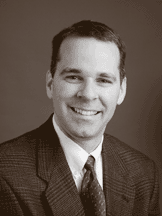 Getting
from here to there
Getting
from here to there
By Brian R. Hook ’94
If you build it, they will come – and go. That is Edward Zuercher’s
’87 goal as public transit director for the city of Phoenix
as he oversees a major expansion plan that includes a new light-rail
system.
Zuercher comes to work every day to plan how to literally connect
communities. The high-school teacher turned public administrator
is responsible for the growing metropolitan area’s public transportation
system. The first phase of construction – 24 miles of track
– is set to begin next year on what will be a 60-mile light-rail
system. Passengers will climb aboard by 2006.
The greater Phoenix area is in need of a better public transit system,
Zuercher said, in part because the southwest metropolis will be
the third largest city in the United States by 2040.
“We are in the infancy of building a transportation system
for a large metropolitan area,” said Zuercher. “No great
city in the world is without a good public transit system.”
City models predict that 25,000 to 40,000 people will use the light-rail
per day, which is equivalent to four lanes worth of freeway traffic
– and there is no room for additional freeways in the central
part of the city. “We will have the carrying capacity at rush
hour of two lanes of freeway in each direction,” said Zuercher.
To implement this new public transportation program, Zuercher is
working with a three-city consortium on the light-rail system, and
the bus expansion plan encompasses cooperative agreements with the
major cities throughout the valley region.
Zuercher described the process of designing a public transportation
system as connecting dots – very complicated dots. He said
planners need to consider many variables, such as high employment
corridors or major sporting venues, including professional football,
baseball, basketball and hockey in Phoenix.
“You need to see where people are living, where they are working
and where they want to go for activities. When you do that, the
things just sort of naturally draw themselves,” said Zuercher.
“You design a system that serves those corridors.”
Implementing the new transportation plan is not his only task as
public transit director. Zuercher must balance the expansion with
several existing programs, including transit service for the disabled.
“It is important to make sure that we keep up with demands
so that disabled residents have equal access to employment and events,”
said Zuercher.
Another growing area in public transportation is the need for additional
bus service catering to smaller neighborhood systems, Zuercher said,
which is “always a demand.”
A public transportation system user himself, Zuercher said that
for most of the city’s riders, public transit is a lifeline.
About two-thirds of the people who ride the buses have no other
option. “They either have one car in a family or no cars. We
are how they get to work or how they get to school,” he said.
“It’s important for people to have good alternatives to
a car, because not everyone can afford a vehicle. And there are
those who want an alternative to vehicles – they can afford
one, but they don’t want to own one for environmental or financial
reasons.”
Zuercher said Goshen College helped prepare him for his current
role, even though his major was in education. “I got a liberal
arts degree that challenged my worldview. I think it gave me a heart
for empathizing with people. The reason that I have gotten where
I am is because I have a sense of serving people. That goes a long
way in local government.”
Public administration was not on Zuercher’s career map when
he graduated from Goshen College with a degree in English secondary
education. He taught English and American history courses at Hesston
(Kan.) High School for several years, then decided to move on, in
a master’s degree program in public administration at the University
of Kansas. For his required full-year, full-time internship in 1994,
Zuercher was selected to work with the city manager of Phoenix,
which turned into a job after graduation. After performing a number
of different duties, he was named as an assistant to the city manager.
Through that position, he was assigned to work on the light-rail
system two years ago.
“Then the public transit directorship became open and I applied
for that last fall and was selected. And so, here I am,” said
Zuercher. The department has 65 employees and a $110 million budget.
In addition, 1,500 contractors work for the department. “There
is a lot of satisfaction in just managing a large group of people
to accomplish a task,” said Zuercher. “The other exciting
thing is public transportation, which is a critical public service.
It gets at the heart of what cities provide for residents.”
Looking toward the future, Zuercher said that he has no intentions
of leaving behind public leadership; within Phoenix alone there
are 26 departments and 13,000 employees in city government. “To
advance and to get new challenges, you don’t have to move physically.
You can stay within the city and do lots of different things,”
he said. “I really enjoy working in local government –
it is right on the front line with people and their immediate needs.
And Phoenix is a great place for that.” Editor’s note:
Brian R. Hook is a freelance journalist based in St. Louis. He has
written for dozens of publishers, including Dow Jones, Financial
Times and Kiplinger Personal Finance. He can be reached by e-mail
at
brhook@msn.com
